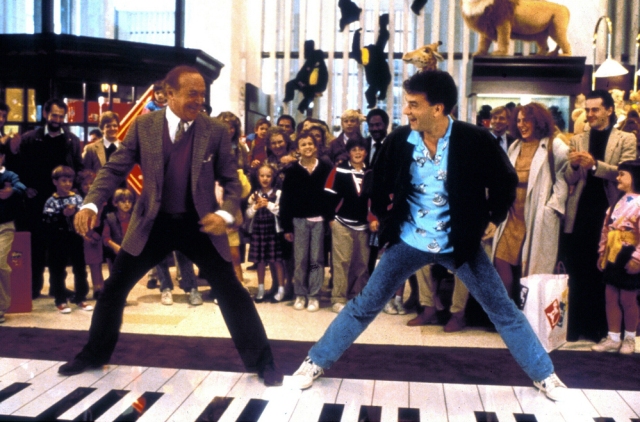Certain actors get typecast for a reason. They just exude a specific trait with such intensity that it’s almost impossible to buy them in any other role. Although Jack Nicholson has a marvelous range, 90% of his most memorable roles involve him being some type of crazy because he brings manic energy like few others. Tom Cruise has perfected the cocky but sensitive pretty boy. And, with the possible exception of Jimmy Stewart, no one has been better at portraying the all-American innocent than Tom Hanks. Maybe it’s his big, puppy dog eyes. It’s definitely his boyish good looks. But there’s just something about Tom Hanks that screams purity and tenderness. It’s partly why I think he’s overrated as an actor. He plays the same types of roles so much (Philadelphia a massive exception). But in his original wide-eyed innocent man role, 1988’s sweet and charming Big, I was reminded why I can’t help but love Tom Hanks in comedic roles.
After making a wish at a carnival genie machine to be big, despondent 12 year old Joshua Baskins is transformed into the 30 year old version of himself (Tom Hanks). And when his new form terrifies his mother and makes everyone think he’s been kidnapped, Josh is forced to run away with the help of his best friend to New York City to lay low until they can find the same fortunetelling machine and switch Josh back. But being a grown-up means having grown-up problems and Josh is forced to get a job as a computer technician for a big toy company. And after impressing his both with his youthful enthusiasm and childlike knack for knowing what makes great toys, Josh quickly rises up the ranks of the company and even begins a relationship with the gorgeous Susan (Elizabeth Perkins). Josh is living the high-life but it isn’t long before he finds himself yearning for the childhood he’s abandoned.
The ease with which Tom Hanks seems to slip into the role of a 12 year old boy stuck in a 30 year old’s body speaks leagues about why Hanks would ultimately spend the rest of his career playing the same type of characters. He’s a marvel. If Hanks metaphorically winked at the camera once or lent the performance even the slightest hint of camp at any time, the whole film would have fallen apart. But what makes Big so special (besides Penny Marshall’s great direction and Gary Ross’s great script) is that it’s played with such sincerity. Hanks seemingly taps into the natural wonder, joy, and innocence of childhood so effortlessly that he’s the emotional center that keeps you wrapped in this film’s heart and whimsy. And he’s buoyed by such great support from Robert Loggia as his boss, the seductive Elizabeth Perkins as the ice queen his warmth defrosts, and the great young talent Jared Rushton as his best friend Billy Kopecky.
But even more than Hanks, the film features a truly winning script. I was consistently bowled over by how much I allowed myself to enjoy this film despite my own sneaking suspicions that I’m a jaded, cynical bastard at heart. The film works on two levels and it’s the interplay between these two competing subtexts that makes Big such a lovely movie. On the one hand (and the primary place this film operates), it’s simply a good-spirited fantasy about what kids wish being an adult meant. It’s escapism but a ton of fun. But on the other hand (and where I got the most pleasure from the movie), it’s also a scathing satire of the greed and narcissism at the heart of the 1980s and the “me” generation. Though Josh is just a child, he’s more caring and giving and level-headed than most of the jerks he works with, particularly the ladder-climbing shark played by Home Alone‘s John Heard. It’s the great type of kid movie that works for both the parents and the kids.
This is one of those “classic” films that for whatever reason I never got around to watching. It just never had a priority in my personal film education so thank the blog gods that they decided it was finally time for me to dive into this lovely movie. I’m not sure if its great, whatever that means. The satire is there is admittedly surface level stuff but still fun and enjoyable. But, sometimes you have to turn the cerebral part of your brain off and just appreciate something as light-hearted and fun as this movie. I can say without question that this is one of my favorite Tom Hanks performances of all time and easily the best of his comedic performances. Part of me wishes the man had just stuck to comedies because he’s never more charming than when you aren’t actually having to dissect the nuances of his characters or his sometimes shallow dramatic characterization.
Final Score: B+





















